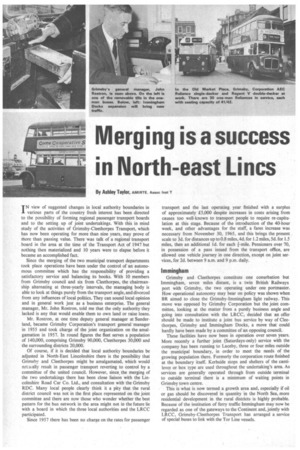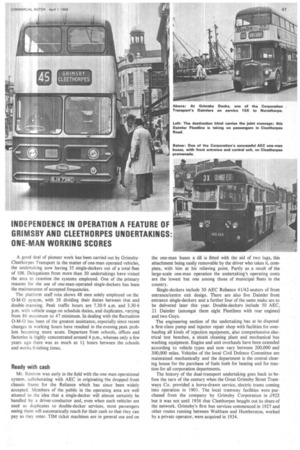Come Co-operative S Merging is a success
Page 48

Page 49

If you've noticed an error in this article please click here to report it so we can fix it.
in North-east Lim
By Ashley Taylor. AMIRTE. Assoc Inst T
I N view of suggested changes in local authority boundaries in various parts of the country fresh interest has been directed to the possibility of forming regional passenger transport boards and to the setting up of joint undertakings. With this in mind study of the activities of Grimsby-Cleethorpes Transport, which has now been operating for more than nine years, may prove of more than passing value. There was talk of a regional transport board in the area at the time of the Transport Act of 1947 but nothing then materialized and 10 years were to elapse before it became an accomplished fact.
Since the merging of the two municipal transport departments took place operations have been under the control of an autonomous committee which has the responsibility of providing a satisfactory service and balancing its books. With 10 members from Grimsby council and six from Cleethorpes, the chairmanship alternating at three-yearly intervals, the managing body is able to look at things purely from the transport angle, and divorced from any influences of local politics. They can sound local opinion and in general work just as a business enterprise. The general .manager, Mr. John Rostron, told me that the only authority they lacked is any that would enable them to own land or raise loans.
Mr. Rostron, at one time deputy general manager at Sunderland, became Grimsby Corporation's transport general •manager in 1955 and took charge of the joint organization on the amalgamation in 1957. In round figures the fleet serves a population of 140,000, comprising Grimsby 90,000, Cleethorpes 30,000 and the surrounding districts 20,000.
Of course, if it is decided that local authority boundaries be adjusted in North-East Lincolnshire there is the possibility that Grimsby and Cleethorpes might be amalgamated, which would net:wally result in passenger transport reverting to control by a committee of the united council. However, since_ the merging of the two undertakings there has been close liaison with the Lincolnshire Road Car Co. Ltd., and consultation with the Grimsby RDC. Many local people clearly think it a pity that the rural district council was not in the first place represented on the joint committee and there are now those who wonder whether the best pattern for the bus network in the area might not in the future lie with a board in which the three local authorities and the LRCC participated.
Since 1957 there has been no charge on the rates for passenger
transport and the last operating year finished with a surplus of approximately £5,000 despite increases in costs arising from causes too well-known to transport people to require re-capitulation at this stage. Because of the introduction of the 40-hour week, and other advantages for the staff, a fares increase was necessary from November 30, 1965. and this brings the present scale to 3d. for distances up to 0.8 miles, 4d. for 1.2 miles, 5d. for 1.5 miles, then an additional id. for each +-mile. Pensioners over 70, in possession of a pass issued from the transport office, are allowed one vehicle journey in one direction, except on joint services, for 2d. between 9 a.m. and 9 p.m. daily.
Immingham
Grimsby and Cleethorpes constitute one conurbation but Immingham, seven miles distant, is a twin British Railways port with Grimsby, the two operating under one portmaster. How operational autonomy may bear on policy was shown when BR aimed to close the Grimsby-Immingham light railway. This move was opposed by Grimsby Corporation but the joint committee, looking at the matter from a purely business angle and going into consultation with the LRCC, decided that an offer should be made to institute a joint bus service by way of Cleethorpes, Grimsby and Immingham Docks, a move that could hardly have been made by a committee of an opposing council.
These facilities have now been in operation over seven years. More recently a further joint (Saturdays-only) service with the company has been running to Laceby, three or four miles outside the municipal boundary, in order to meet the needs of the growing population there. Formerly the corporation route finished at the boundary itself. Kerbside stops and shelters of the cantilever, or box type are used throughout the undertaking's area. As services are generally operated through from outside terminal to outside terminal there is a minimum of waiting points in Grimsby town centre.
This is what is now termed a growth area and, especially if oil or gas should be discovered in quantity in the North Sea, more residential development in the rural districts is highly probable. Because of the institution of ferry traffic Immingham may now be regarded as one of the gateways to the Continent and, jointly with LRCC, Grimsby-Cleethorpes Transport has arranged a service of special buses to link with the Tor Line vessels. A good deal of pioneer work has been carried out by GrimsbyCleethorpes Transport in the matter of one-man operated vehicles, the undertaking now having 35 single-deckers out of a total fleet of 108. Delegations from more than 30 undertakings have visited the area to examine the systems employed. One of the primary reasons for the use of one-man-operated single-deckers has been the maintenance of accepted frequencies.
The platform staff rota shows 48 men solely employed on the O-M-0 system. with 38 dividing their duties between that and double-manning. Peak traffic hours are 7.30-9 a.m. and 3.30-6 p.m. with vehicle usage on schedule duties, and duplicates, varying from 86 maximum to 47 minimum. In dealing with the fluctuation O-M-O has been of the greatest assistance, especially since recent changes in working hours have resulted in the evening peak problem becoming more acute. Departure from schools, offices and factories is highly concentrated around 4 p.m., whereas only a few years ago there was as much as 1+ hours between the schools and works finishing times.
Ready with cash Mr. Rostron was early in the field with the one-man operational system, collaborating with AEC in originating 'the dropped front chassis frame for the Reliance which has since been widely accepted. Members of the public in the operating area are well attuned to the idea that a single-decker will almost certainly be handled by a driver-conductor and, even when such vehicles are used as duplicates to double-decker services, most passengers seeing them will automatically reach for their cash so that they can pay as they enter. TIM ticket machines are in general use and on the one-man buses a till is fitted with the aid of two lugs, this attachment being easily removable by the driver who takes it. complete, with him at his relieving point. Partly as a result of the large-scale one-man operation the undertaking's operating costs are the lowest but one among those of municipal fleets in the country.
Single-deckers include 30 AEC Reliance 41/42-seaters of front entrance/centre exit design. There are also five Daimler front entrance single-deckers and a further four of the same make are to be delivered later this year. Double-deckers include 50 AEC, 21 Daimler (amongst them eight Fleetlines with rear engines) and two Guys.
The engineering section of the undertaking has at its disposal a first-class pump and injector repair shop with facilities for overhauling all kinds of injection equipment, also domprehensive electrical test benches, a steam cleaning plant and mechanical bus washing equipment. Engine and unit overhauls have been extended according to vehicle types and now vary between 200,000 and 300,000 miles. Vehicles of the local Civil Defence Committee are maintained mechanically and the department is the central clearing house for the purchase of fuels both for heating and for traction for all corporation departments.
The history of the dual-transport undertaking goes back to before the turn of the century when the Great Grimsby Street Tramways Co. provided a horse-drawn service, electric trams coming into operation in 1901. The local tramway facilities were purchased from the company by Grimsby Corporation in .1925 but it was not until 1936 that Cleethorpes bonght out its share of the network. Grimsby's first bus services commenced in 1927 and other routes running between Waltham and Humberston, worked by a private operator, were acquired in 1934.




















































































































